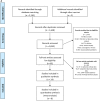Obstructive Sleep Apnea Syndrome, Objectively Measured Physical Activity and Exercise Training Interventions: A Systematic Review and Meta-Analysis
- PMID: 29520251
- PMCID: PMC5827163
- DOI: 10.3389/fneur.2018.00073
Obstructive Sleep Apnea Syndrome, Objectively Measured Physical Activity and Exercise Training Interventions: A Systematic Review and Meta-Analysis
Abstract
A systematic review of English and French articles using Pubmed/Medline and Embase included studies assessing objective physical activity levels of obstructive sleep apnea (OSA) patients and exploring the effects of exercise training on OSA severity, body mass index (BMI), sleepiness, and cardiorespiratory fitness [peak oxygen consumption (VO2peak)]. Two independent reviewers analyzed the studies, extracted the data, and assessed the quality of evidence. For objective physical activity levels, eight studies were included. The mean number of steps per day across studies was 5,388 (95% CI: 3,831-6,945; p < 0.001), which was by far lower than the recommended threshold of 10,000 steps per day. For exercise training, six randomized trials were included. There was a significant decrease in apnea-hypopnea-index following exercise training (mean decrease of 8.9 events/h; 95% CI: -13.4 to -4.3; p < 0.01), which was accompanied by a reduction in subjective sleepiness, an increase in VO2peak and no change in BMI. OSA patients present low levels of physical activity and exercise training is associated with improved outcomes. Future interventions (including exercise training) focusing on increasing physical activity levels may have important clinical impacts on both OSA severity and the burden of associated co-morbidities. Objective measurement of physical activity in routine OSA management and well-designed clinical trials are recommended. Registration # CRD42017057319 (Prospero).
Keywords: exercise training; meta-analysis; obstructive sleep apnea; physical activity; randomized controlled trials; systematic review.
Figures









Similar articles
-
Effects of exercise training on sleep apnea: a meta-analysis.Lung. 2014 Feb;192(1):175-84. doi: 10.1007/s00408-013-9511-3. Lung. 2014. PMID: 24077936 Free PMC article. Review.
-
Effect of exercise training on subjective parameters in patients with obstructive sleep apnea: a systematic review and meta-analysis.Sleep Med. 2020 May;69:1-7. doi: 10.1016/j.sleep.2019.12.022. Epub 2020 Jan 14. Sleep Med. 2020. PMID: 32045849
-
Effectiveness of aerobic exercise training in patients with obstructive sleep apnea: a systematic review and meta-analysis.Eur Arch Otorhinolaryngol. 2025 May 6. doi: 10.1007/s00405-025-09436-3. Online ahead of print. Eur Arch Otorhinolaryngol. 2025. PMID: 40329037 Review.
-
Does obstructive sleep apnea affect exercise capacity and the hemodynamic response to exercise? An individual patient data and aggregate meta-analysis.Sleep Med Rev. 2019 Jun;45:42-53. doi: 10.1016/j.smrv.2019.03.002. Epub 2019 Mar 14. Sleep Med Rev. 2019. PMID: 30933881 Review.
-
Physiological correlates to spontaneous physical activity variability in obese patients with already treated sleep apnea syndrome.Sleep Breath. 2017 Mar;21(1):61-68. doi: 10.1007/s11325-016-1368-2. Epub 2016 Jun 18. Sleep Breath. 2017. PMID: 27318994
Cited by
-
Effects of Exercise in Patients with Obstructive Sleep Apnoea.Clocks Sleep. 2021 Mar 3;3(1):227-235. doi: 10.3390/clockssleep3010013. Clocks Sleep. 2021. PMID: 33802403 Free PMC article. Review.
-
The effects of an exercise intervention on executive function among overweight adults with obstructive sleep apnea.Sleep Biol Rhythms. 2023 Apr;21(2):185-191. doi: 10.1007/s41105-022-00433-1. Epub 2022 Nov 21. Sleep Biol Rhythms. 2023. PMID: 37143578 Free PMC article.
-
Association of step counts over time with the risk of chronic disease in the All of Us Research Program.Nat Med. 2022 Nov;28(11):2301-2308. doi: 10.1038/s41591-022-02012-w. Epub 2022 Oct 10. Nat Med. 2022. PMID: 36216933 Free PMC article.
-
The implementation of a physical activity intervention in adults with Obstructive Sleep Apnoea over the age of 50 years: a feasibility uncontrolled clinical trial.BMC Sports Sci Med Rehabil. 2020 Aug 8;12:46. doi: 10.1186/s13102-020-00195-8. eCollection 2020. BMC Sports Sci Med Rehabil. 2020. PMID: 32782808 Free PMC article.
-
Obstructive Sleep Apnea Syndrome: The Effect of Acute and Chronic Responses of Exercise.Front Med (Lausanne). 2021 Dec 24;8:806924. doi: 10.3389/fmed.2021.806924. eCollection 2021. Front Med (Lausanne). 2021. PMID: 35004785 Free PMC article. Review.
References
LinkOut - more resources
Full Text Sources
Other Literature Sources
Medical

